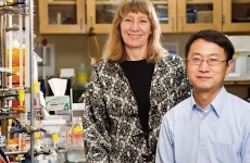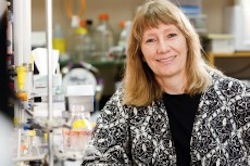 There may be a connection between two different types of cell wall glycans (sugars) and specific wall protein known as arabinogalactan protein. The initial discovery was made by Li Tan, who then approached researchers at the University of Georgia (UGA to continue the research. According to Tan and Debra Mohnen, who both work at part of the BioEnergy Science Center, this connection is not known to exist and does not conform to the commonly held scientific definitions of plant cell wall structure. Yet what they found could redefine the understanding of basic plant biology, and it may lead to significant improvements in the growth and processing of biofuel crops.
There may be a connection between two different types of cell wall glycans (sugars) and specific wall protein known as arabinogalactan protein. The initial discovery was made by Li Tan, who then approached researchers at the University of Georgia (UGA to continue the research. According to Tan and Debra Mohnen, who both work at part of the BioEnergy Science Center, this connection is not known to exist and does not conform to the commonly held scientific definitions of plant cell wall structure. Yet what they found could redefine the understanding of basic plant biology, and it may lead to significant improvements in the growth and processing of biofuel crops.
“This is totally new,” said Tan, a research scientist in the Complex Carbohydrate Research Center and lead author of a paper detailing the group’s findings published in the online journal The Plant Cell. “We had never seen linkages between these structures before, and we had to develop a variety of new tests to prove that what we saw was not simply a mistake or a contamination.”
The scientific community generally agrees that complex sugars like pectin and xylan, which allow for cell wall structure, extension and growth, exist in separate networks from cell wall proteins. However, the UGA researchers have identified a direct and indisputable link between these two domains.
“What this means is that plant scientists’ view of the plant cell wall is at least partially wrong,” said Mohnen, professor of biochemistry and molecular biology and also a member of UGA’s Complex Carbohydrate Research Center. “There have been hints over the last 30 or 40 years that this link might exist, but no one has been able to prove it until now.”
According to the researchers, the discovery has many far-reaching implications beyond the ways it may change biology textbooks. While scientists looks to develop alternatives to fossil-fuel based energy, biofuels created from cultivated crops like trees and grasses show great promise as a carbon-neutral source of ethanol. Yet converting plants into fuel that  might be used to power automobiles or create heat for homes has proven difficult because plants are resistant to breakdown and the sugars needed to create biofuels are locked inside a plant’s cell walls.
might be used to power automobiles or create heat for homes has proven difficult because plants are resistant to breakdown and the sugars needed to create biofuels are locked inside a plant’s cell walls.
But Tan and Mohnen are hopeful that their discovery combined with additional research will reveal many of the secrets of plant cell wall architecture and function, making them easier to break down or perhaps opening the doors for engineered plants that will work better as a feedstock for the biofuels industry and as better agricultural products.
“The applications that will emerge from this discovery are enormous,” said Mohnen. “It’s all going to stem from a refined understanding of how plants are put together and how they are made, but once we know that, we can start modifying them to make them perform in ways that are most advantageous to us. We’ve only just scratched the surface, but once we investigate this further and we understand the plant exceptionally well, the sky’s the limit.”

